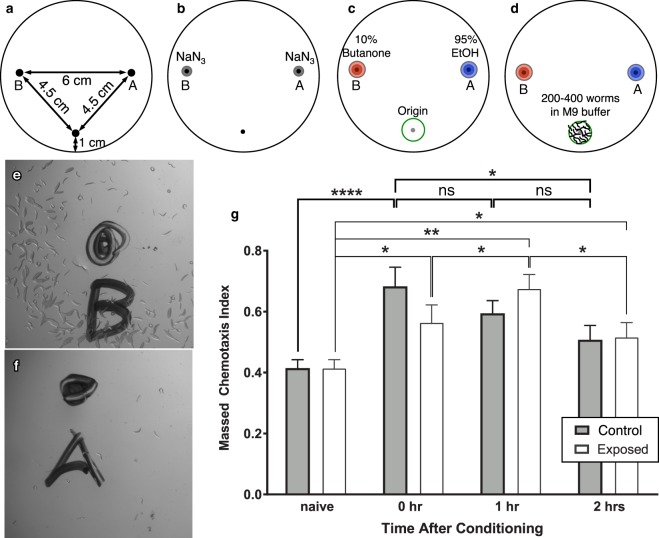Figure 3.
Chemotaxis assay (a–f) procedure and (g) results. The origin (at bottom), butanone (at left), and EtOH (at right) spots were (a) marked underneath a transparent plate. (b) First, 1 μL NaN3 was added to each of the butanone and EtOH spots. (c) Then 1 μL each of 10% butanone and 95% EtOH were respectively added to the spots on the left and right sides of the plate. (d) Immediately after being trained via the learning assay, 200 to 400 worms suspended in M9 buffer were then added to the plate over the “origin”. Upon reaching the (e) butanone and (f) EtOH spots, the worms were paralyzed and counted. In this way, the effect of 10 s of 500 mW 20-MHz SAW on associative learning and short-term associative memory of C. elegans worms may be (g) compared to worms unexposed to SAW. Unexposed worms showed significant learning ability (****p < 0.0002), and their short-term memory lasts for ~2 hours with an insignificant decline in their learning ability over that time (ns, p > 0.05 for 0–1 hr and 1–2 hrs). SAW-exposed worms exhibited a weakly significant change in the massed chemotaxis index (*p < 0.05) post-conditioning. The SAW-exposed worms showed a continued increase in learning ability to 1 hour after conditioning (*p < 0.05), followed by a decrease in learning ability from 1 to 2 hours after conditioning (*p < 0.05). The massed chemotaxis index significantly increased with respect to the unexposed (naïve) worms one hour after training (**p < 0.007). The naïve–0 hr, naïve–1 hr, and naïve–2 hr runs were each repeated four times (N = 4) for both the control and SAW-exposed conditions, with n = 200–400 worms for each and every repeat. Significance was based upon the entire data set with a two-way ANOVA with , where *p < 0.05, **p < 0.007, ***p < 0.0005 and ****p < 0.0002. Normality of the data was assessed using the Shapiro-Wilk test with *p > α indicating the experimental data was normally distributed.

